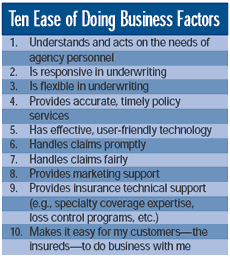
How does the carrier-agency relationship affect the buying decision? More pointedly, how does the ease—or difficulty—of doing business with a carrier affect the agent’s decision of whether to place more or less of their business with that carrier? These questions are answered by the results of the second annual Ease of Doing Business (EDB) survey recently completed by Deep Customer Connections Inc.
We received more than 3,000 carrier ratings from agency personnel—principals, producers, CSRs and others. Agents emphasized that “EDB is a critically important factor in choosing a carrier with which to place business” by rating it 3.824 on a four-point scale. At least 96 percent of the respondents strongly agreed with this statement.
Overall survey results
Figure 1 shows consolidated responses including importance rating for each EDB factor as well as all the performance ratings for more than 100 carriers. The importance ratings represent what the average independent agent is looking for in their working relationship with carriers—a kind of proxy for agent expectations.
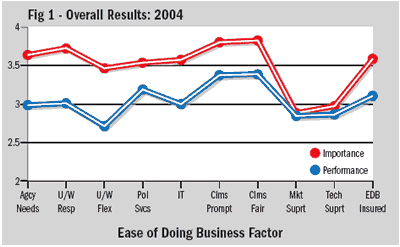
As we review the results for different groupings of carriers, notice stability in the importance ratings while performance ratings vary substantially. The same pattern—stable importance but considerably more varied performance ratings—also applies to an individual carrier’s ratings.
National carriers
Performance scores for a group of national carriers closely tracks the overall results with two clear exceptions: “providing accurate, timely policy services” and “having effective, user-friendly technology.” (See Figure 2, National Carrier Results).
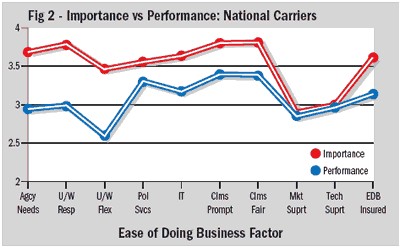
The higher national carriers’ scores for these two factors likely reflect the major investments they have made in building and deploying proprietary technology platforms that provide direct data links between them and their agents. But most agents do not realize the full intended benefit of the improved transactional efficiency because of the number of different proprietary systems they are asked to utilize.
Regional cluster carriers
We have created a grouping of several firms that operate a group of regional carriers and, for the most part, are large publicly held insurance companies. While the regional cluster carriers vary in terms of their degree of marketing or operational integration, these “hybrids” seek the closer connection to agents ascribed to small regional carriers along with the operational efficiency that comes with larger size and scale. An example of such a company, Liberty Mutual, has several regionals, each with separate names and specific operating territories.
With nearly identical importance ratings, the performance scores for the regional cluster carriers are significantly below the nationals in “provides accurate, timely policy services” and even lower in “has effective, user-friendly technology.” They enjoy an advantage in “underwriting flexibility,” but they also under perform the nationals in “marketing support,” “insurance technical support,” and “makes it easy for my customers—the insureds—to do business with me.”
These regional cluster carriers have not yet achieved the promise of technology, and shown little sign so far of capitalizing on having a more local touch.
Large regional carriers
We selected 10 companies as large regional carriers with operating territories in 18 to 32 states. Most are large, publicly traded companies.
Compared to the nationals, large regional carriers’ performance shows some advantage in “understands and acts on the needs of agency personnel,” being “responsive in underwriting” and especially in being “flexible in underwriting.” They also enjoy a slight edge in handling claims promptly and fairly, the factors rated most important. But, like the regional clusters, these large regional carriers were dominated by the nationals in policy services and user-friendly technology.
They generally enjoy a small edge over the performance of the regional cluster carriers, and have a significant advantage in “user-friendly, effective technology,” “handling claims promptly,” and “marketing support.”
Carriers with a high EDB index
To offer a single point of comparison, we developed the Ease of Doing Business Index (EDBI). The EDBI, which measures how close a carrier’s performance scores come to their own agents’ expectations, is calculated from a combination of the gap between the importance and performance scores on all EDB factors weighted by the importance given to each factor.
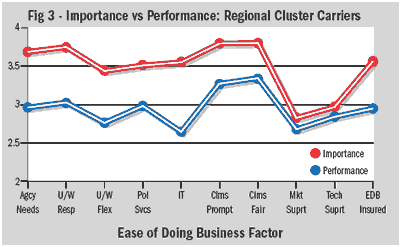
Thus, more emphasis in the calculation of the EDB Index is given to those factors that received higher importance ratings by the agents. This group was selected based on an EDB Index of at least 90 out of a possible 100 points.
Carriers with a high EDB Index collectively outperformed large regionals and regional clusters on all EDB Factors, and they outperformed the nationals on 9 of the 10 factors. Of course, the question is “what is it that creates those significantly different performance ratings by agents?”
What we’ve learned
Clearly, agents have very different working relationship experiences with different carriers. Upon completion of our 2003 EDB survey, we had conversations with executives from over 50 of the 85 carriers rated, including nine of the 12 carriers who comprise the 2004 high EDB Index list.
Those nine carriers characterized the relationship with their agents as being critical to their business success; most explicitly view their agents as their customers and treat them accordingly. There clearly is a different mindset about agents in these firms that is reflected in the way the carriers’ personnel work with agents on a day-to-day basis. On the other side of the ledger, characteristic of many carriers with lower EDB ratings, is a mindset of the “agent as producer,” simply a link in the distribution channel leading to the insured.
Our belief—validated by two years of survey results and hundreds (perhaps thousands) of conversations with scores of people from carriers and agencies—is that EDB ratings are a leading indicator of carrier performance. Here’s the rationale:
Agents—like carriers—look to maximize their profitability.
A significant key to agency profitability is their productivity—literally the volume of work they can put through the agency with given resources.
Critical to that productivity is getting the work done quickly and accurately the first time; avoiding duplicate work and re-work above all.
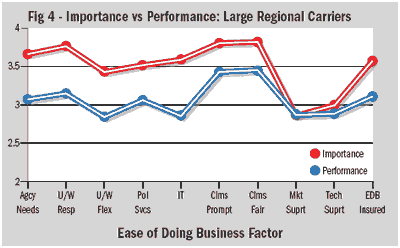
This does not mean that carriers don’t have to do the basics well—providing competitive products at competitive prices and with competitive commissions. But those basics are only tickets into the game rather than differentiators between those who will excel and those who merely get by.
Furthermore, agency personnel would rather send business to carriers who behave in understanding and supportive ways—who “get it” with regard to agency needs.
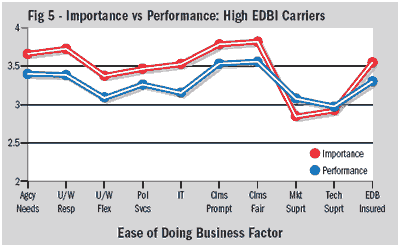
All of this adds up to EDB as a critical differentiator in a competitive marketplace. Recognizing the time lag between actual EDB performance and its impact on growth and profitability, we expect that to survive, those carriers who have low EDB ratings will have to “buy” their way into the market with lower prices, higher commissions or unique products. In contrast, those who excel at EDB will have agents knocking at their doors with more business.
Paul Croke (Paul.Croke@DeepCustomerConnections.com) and Nort Salz (Nort.Salz@DeepCustomerConnections.com) are founding part ners of Deep Customer Connections Inc., a Mass.-based management consulting firm. Visit www.DeepCustomerConnections.com for more information. The authors wish to acknowledge Robert Taylor of Robert Taylor Associates for his help in conducting and analyzing the survey results.
Was this article valuable?
Here are more articles you may enjoy.


 US Property Insurance Rates Fall for First Time Since 2017
US Property Insurance Rates Fall for First Time Since 2017  Home Insurance Customers Staying Put Despite More Shopping Around: J.D. Power
Home Insurance Customers Staying Put Despite More Shopping Around: J.D. Power  Former UPS Driver Wins $238 Million Verdict in Suit Over Firing
Former UPS Driver Wins $238 Million Verdict in Suit Over Firing  D&O Market in ‘State of Transition’ on Litigation Trends: Woodruff Sawyer
D&O Market in ‘State of Transition’ on Litigation Trends: Woodruff Sawyer 


